Harris C.M., Piersol A.G. Harris Shock and vibration handbook
Подождите немного. Документ загружается.


n represent the number of half sine waves in the X and Y directions, respectively. In
each mode there are m − 1 evenly spaced nodal lines parallel to the Y axis, and n − 1
parallel to the X axis.
Rayleigh’s and Ritz’s Methods. The modes of vibration of a rectangular plate
with all edges simply supported are such that the deflection of each section of the
plate parallel to an edge is of the same form as the deflection of a beam with both
ends simply supported. In general, this does not hold true for other combinations of
edge conditions. For example, the vibration of a rectangular plate with all edges built
in does not occur in such a way that each section parallel to an edge has the same
shape as does a beam with both ends built in. A function that is made up using the
mode shapes of beams with built-in ends obviously satisfies the conditions of zero
deflection and slope at all edges, but it cannot be made to satisfy Eq. (7.38).
The mode shapes of beams give logical functions with which to formulate shapes
for determining the natural frequencies, for plates having various edge conditions,
by the Rayleigh or Ritz methods. By using a single mode function in Rayleigh’s
method an approximate frequency can be determined. This can be improved by
using more than one of the modal shapes and using Ritz’s method as discussed
below.
The strain energy of bending and the kinetic energy for plates are given in Table
7.1. Finding the maximum values of the energies, equating them, and solving for
n
2
gives the following frequency equation:
V
max
n
2
=
A
W
2
dx dy
(7.41)
where V is the strain energy.
In applying the Rayleigh method, a function W is assumed that satisfies the nec-
essary boundary conditions of the plate. An example of the calculations is given in
the section on circular plates. If the shape assumed is exactly the correct one, Eq.
(7.41) gives the exact frequency. In general, the correct shape is not known and a
frequency greater than the natural frequency is obtained. The Ritz method involves
assuming W to be of the form W = a
1
W
1
(x,y) + a
2
W
2
(x,y) +
...
in which W
1
, W
2
,...all
satisfy the boundary conditions, and a
1
, a
2
,...are adjusted to give a minimum fre-
quency. Reference 29 is an extensive compilation, with references to sources, of cal-
culated and experimental results for plates of many shapes. Some examples are cited
in the following sections.
Square, Rectangular, and Skew Rectangular Plates. Tables of the functions
necessary for the determination of the natural frequencies of rectangular plates by
the use of the Ritz method are available,
30
these having been derived by using the
modal shapes of beams having end conditions corresponding to the edge condi-
tions of the plates. Information is included from which the complete shapes of the
vibrational modes can be determined. Frequencies and nodal patterns for several
modes of vibration of square plates having three sets of boundary conditions are
shown in Table 7.7. By the use of functions which represent the natural modes of
beams, the frequencies and nodal patterns for rectangular and skew cantilever
plates have been determined
31
and are shown in Table 7.8. Comparison of calcu-
lated frequencies with experimentally determined values shows good agreement.
Natural frequencies of rectangular plates having other boundary conditions are
given in Table 7.9.
γh
2
g
VIBRATION OF SYSTEMS HAVING DISTRIBUTED MASS AND ELASTICITY 7.33
8434_Harris_07_b.qxd 09/20/2001 11:24 AM Page 7.33
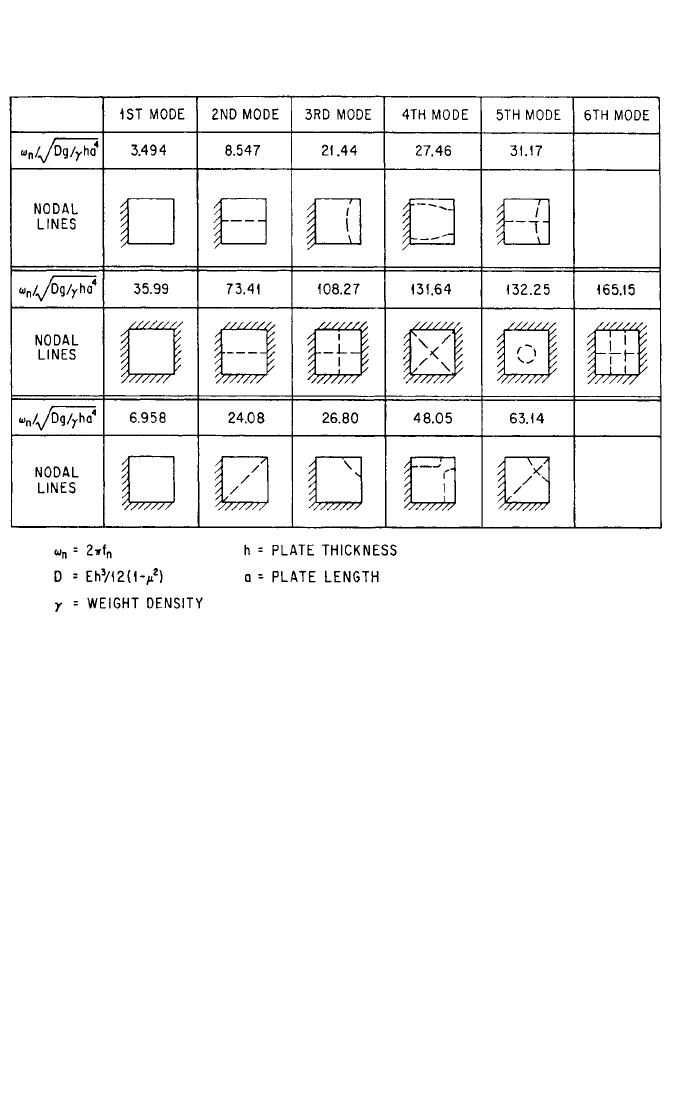
Triangular and Trapezoidal Plates. Nodal patterns and natural frequencies for
triangular plates have been determined
33
by the use of functions derived from the
mode shapes of beams, and are shown in Table 7.10. Certain of these have been com-
pared with experimental values and the agreement is excellent. Natural frequencies
and nodal patterns have been determined experimentally for six modes of vibration
of a number of cantilevered triangular plates
34
and for the first six modes of can-
tilevered trapezoidal plates derived by trimming the tips of triangular plates parallel
to the clamped edge.
35
These triangular and trapezoidal shapes approximate the
shapes of various delta wings for aircraft and of fins for missiles.
Circular Plates. The solution of the problem of small lateral vibration of circular
plates is obtained by transforming Eq. (7.38) to polar coordinates and finding the
solution that satisfies the necessary boundary conditions of the resulting equation.
Omitting the terms involving forces in the plane of the plate,
36
++
++
=κ
4
W (7.42)
where
κ
4
=
γh
n
2
gD
∂
2
W
∂θ
2
1
r
∂W
∂r
1
r
∂
2
W
∂r
2
∂
2
∂θ
2
1
r
∂
∂r
1
r
∂
2
∂r
2
7.34 CHAPTER SEVEN
TABLE 7.7 Natural Frequencies and Nodal Lines of Square Plates with Various Edge Con-
ditions (After D. Young.
29
)
8434_Harris_07_b.qxd 09/20/2001 11:24 AM Page 7.34
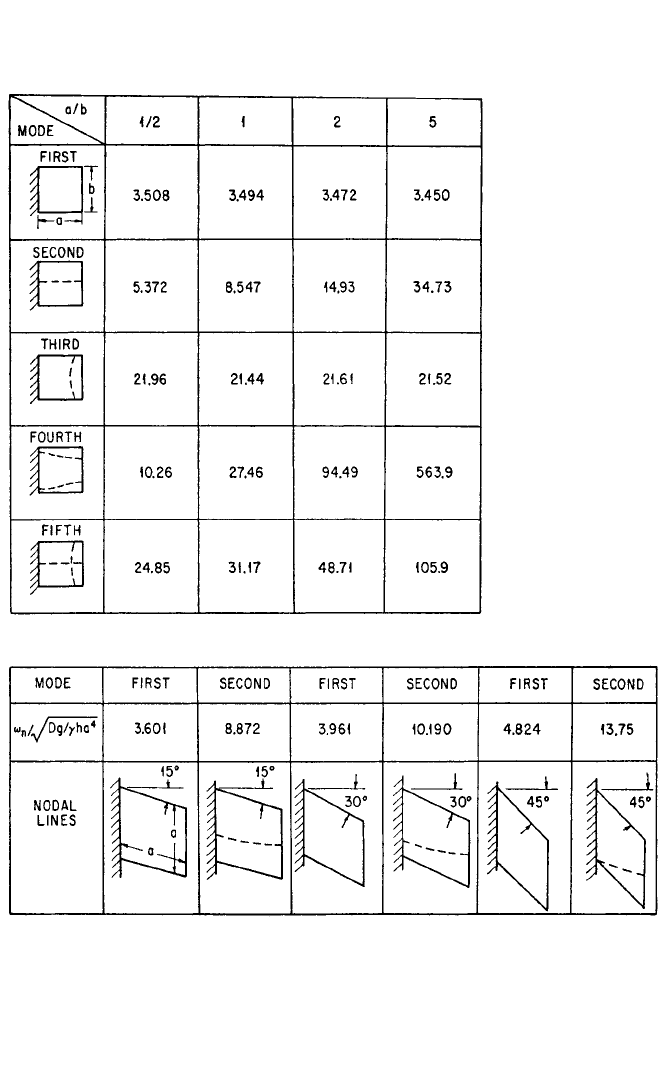
The solution of Eq. (7.42) is
36
W = A cos (nθ−β)[J
n
(κr) +λJ
n
(iκr)] (7.43)
where J
n
is a Bessel function of the first kind. When cos (nθ−β) = 0, a mode having
a nodal system of n diameters, symmetrically distributed, is obtained. The term in
VIBRATION OF SYSTEMS HAVING DISTRIBUTED MASS AND ELASTICITY 7.35
TABLE 7.8 Natural Frequencies and Nodal Lines of Cantilevered Rectangular and Skew
Rectangular Plates (µ=0.3)* (M. V. Barton.
30
)
* For terminology, see Table 7.7.
8434_Harris_07_b.qxd 09/20/2001 11:24 AM Page 7.35
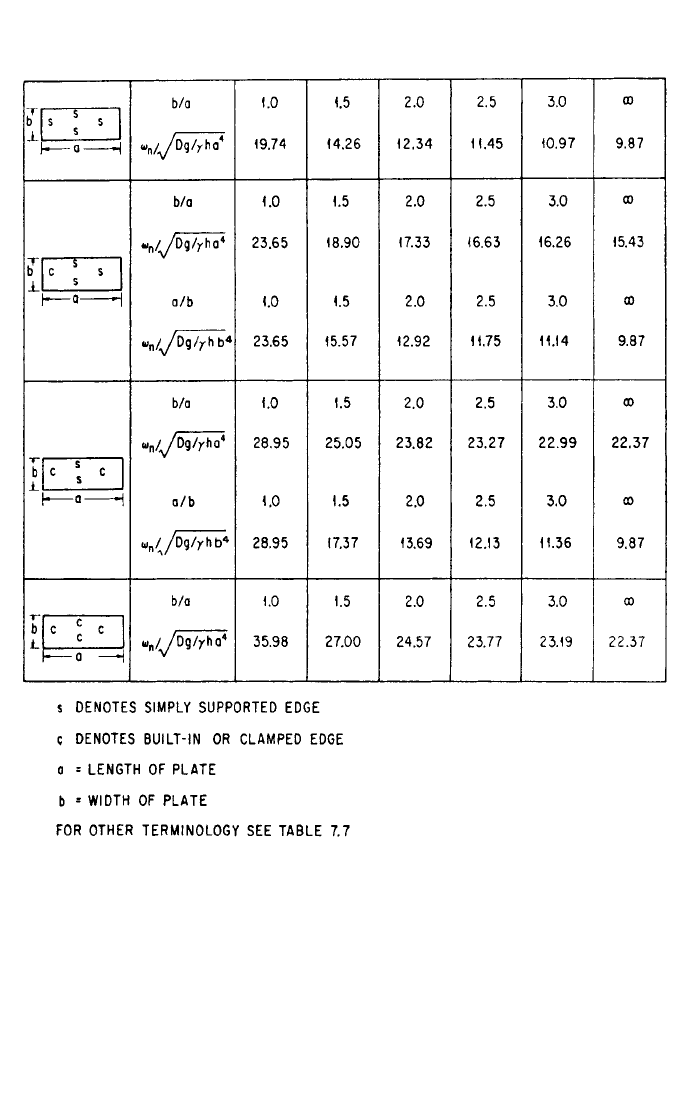
brackets represents modes having concentric nodal circles. The values of κ and λ
are determined by the boundary conditions, which are, for radially symmetrical
vibration:
Simply supported edge:
W = 0 M
1r
= D
+
= 0
Fixed edge:
W = 0 = 0
dW
dr
dW
dr
µ
a
d
2
W
dr
2
7.36 CHAPTER SEVEN
TABLE 7.9 Natural Frequencies of Rectangular Plates (R. F. S. Hearman.
32
)
8434_Harris_07_b.qxd 09/20/2001 11:24 AM Page 7.36
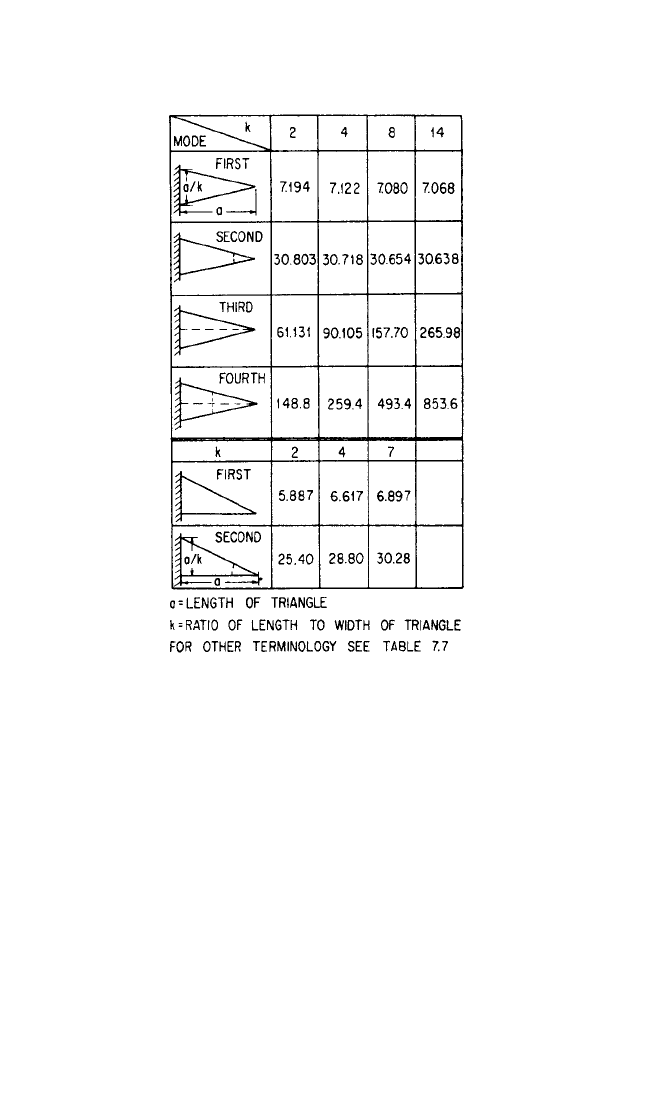
Free edge:
M
1r
= D
+
= 0
+
= 0
EXAMPLE 7.9. The steel diaphragm of a radio earphone has an unsupported
diameter of 2.0 in. and is 0.008 in. thick. Assuming that the edge is fixed, the lowest
three frequencies for the free vibration in which only nodal circles occur are to be
calculated, using the exact method and the Rayleigh and Ritz methods.
EXACT SOLUTION. In this example n = 0, which makes cos (nθ−β) = 1; thus, Eq.
(7.43) becomes
W = A[J
0
(κr) +λI
0
(κr)]
where J
0
(iκr) = I
0
(κr) and I
0
is a modified Bessel function of the first kind.
At the boundary where r = a,
= Aκ[−J
1
(κa) +λI
1
(κa)] = 0 −J
1
(κa) +λI
1
(κa) = 0
The deflection at r = a is also zero:
∂W
∂r
dW
dr
1
r
d
2
W
dr
2
d
dr
dW
dr
µ
a
d
2
W
dr
2
VIBRATION OF SYSTEMS HAVING DISTRIBUTED MASS AND ELASTICITY 7.37
TABLE 7.10 Natural Frequencies and
Nodal Lines of Triangular Plates (B. W.
Anderson.
33
)
8434_Harris_07_b.qxd 09/20/2001 11:24 AM Page 7.37

J
0
(κa) +λI
0
(κa) = 0
The frequency equation becomes
λ= =−
The first three roots of the frequency equation are: κa = 3.196, 6.306, 9.44. The cor-
responding natural frequencies are, from Eq. (7.42),
ω
n
=
For steel, E = 30 × 10
6
lb/in.
2
, γ=0.28 lb/in.
3
, and µ=0.28. Hence
D == =1.38 lb-in.
Thus, the lowest natural frequency is
ω
1
= 10.21
= 4960 rad/sec = 790 Hz
The second frequency is 3070 Hz, and the third is 6880 Hz.
SOLUTION BY RAYLEIGH’S METHOD. The equations for strain and kinetic ener-
gies are given in Table 7.1. The strain energy for a plate with clamped edges becomes
V =πD
a
0
+
2
r dr
The maximum kinetic energy is
T =
a
0
W
2
r dr
An expression of the form W = a
1
[1 − (r/a)
2
]
2
, which satisfies the conditions of zero
deflection and slope at the boundary, is used. The first two derivatives are ∂W/∂r =
a
1
(−4r/a
2
+ 4r
3
/a
4
) and ∂
2
W/∂r
2
= a
1
(−4/a
2
+ 12r
2
/a
4
). Using these values in the equa-
tions for strain and kinetic energy, V = 32πDa
1
2
/3a
2
and T =ω
n
2
πγha
2
a
1
2
/10g. Equat-
ing these values and solving for the frequency,
ω
n
=
=
This is somewhat higher than the exact frequency.
SOLUTION BY RITZ’S METHOD. Using an expression for the deflection of the form
W = a
1
[1 − (r/a)
2
]
2
+ a
2
[1 − (r/a)
2
]
3
and applying the Ritz method, the following values are obtained for the first two
frequencies:
ω
1
=
ω
2
=
The details of the calculations giving this result are in the literature.
37
The first fre-
quency agrees with the exact answer to four significant figures, while the second fre-
Dg
γh
43.04
a
2
Dg
γh
10.21
a
2
Dg
γh
10.33
a
2
320 Dg
3a
4
γh
ω
n
2
πγh
g
∂W
∂r
1
r
∂
2
W
∂r
2
(1.38)(386)
(0.28)(0.008)
30 × 10
6
(0.008)
3
12(1 − 0.078)
Eh
3
12(1 −µ
2
)
Dg
γh
88.9
a
2
Dg
γh
39.77
a
2
Dg
γh
10.21
a
2
J
0
(κa)
I
0
(κa)
J
1
(κa)
I
1
(κa)
7.38 CHAPTER SEVEN
8434_Harris_07_b.qxd 09/20/2001 11:24 AM Page 7.38

quency is somewhat high. A closer approximation to the second frequency and
approximations of the higher frequencies could be obtained by using additional
terms in the deflection equation.
The frequencies of modes having n nodal diameters are:
37
n = 1: ω
1
=
n = 2: ω
2
=
For a plate with its center fixed and edge free, and having m nodal circles, the fre-
quencies are:
38
m 01 2 3
ω
n
a
2
/
3.75 20.91 60.68 119.7
Stretching of Middle Plane. In the usual analysis of plates, it is assumed that the
deflection of the plate is so small that there is no stretching of the middle plane. If
such stretching occurs, it affects the natural frequency.Whether it occurs depends on
the conditions of support of the plate, the amplitude of vibration, and possibly other
conditions. In a plate with its edges built in, a relatively small deflection causes a sig-
nificant stretching.The effect of stretching is not proportional to the deflection; thus,
the elastic restoring force is not a linear function of deflection. The natural fre-
quency is not independent of amplitude but becomes higher with increasing ampli-
tudes. If a plate is subjected to a pressure on one side, so that the vibration occurs
about a deflected position, the effect of stretching may be appreciable. The effect of
stretching in rectangular plates with immovable hinged supports has been dis-
cussed.
39
The effect of the amplitude on the natural frequency is shown in Fig. 7.11;
the effect on the total stress in the plate is shown in Fig. 7.12. The natural frequency
increases rapidly as the amplitude of vibration increases.
Rotational Motion and Shearing Forces. In the foregoing analysis, only the
motion of each element of the plate in the direction normal to the plane of the
plate is considered.There is also rotation of each element, and there is a deflection
associated with the lateral shearing forces in the plate. The effects of these factors
becomes significant if the curvature of the plate is large relative to its thickness,
i.e., for a plate in which the thickness is large compared to the lateral dimensions
or when the plate is vibrating in a mode for which the nodal lines are close
together.These effects have been analyzed for rectangular plates
40
and for circular
plates.
41
Complete Circular Rings. Equations have been derived
42,43
for the natural fre-
quencies of complete circular rings for which the radius is large compared to the
thickness of the ring in the radial direction. Such rings can execute several types of
free vibration, which are shown in Table 7.11 with the formulas for the natural fre-
quencies.
Dg
γh
Dg
γh
34.84
a
2
Dg
γh
21.22
a
2
VIBRATION OF SYSTEMS HAVING DISTRIBUTED MASS AND ELASTICITY 7.39
8434_Harris_07_b.qxd 09/20/2001 11:24 AM Page 7.39
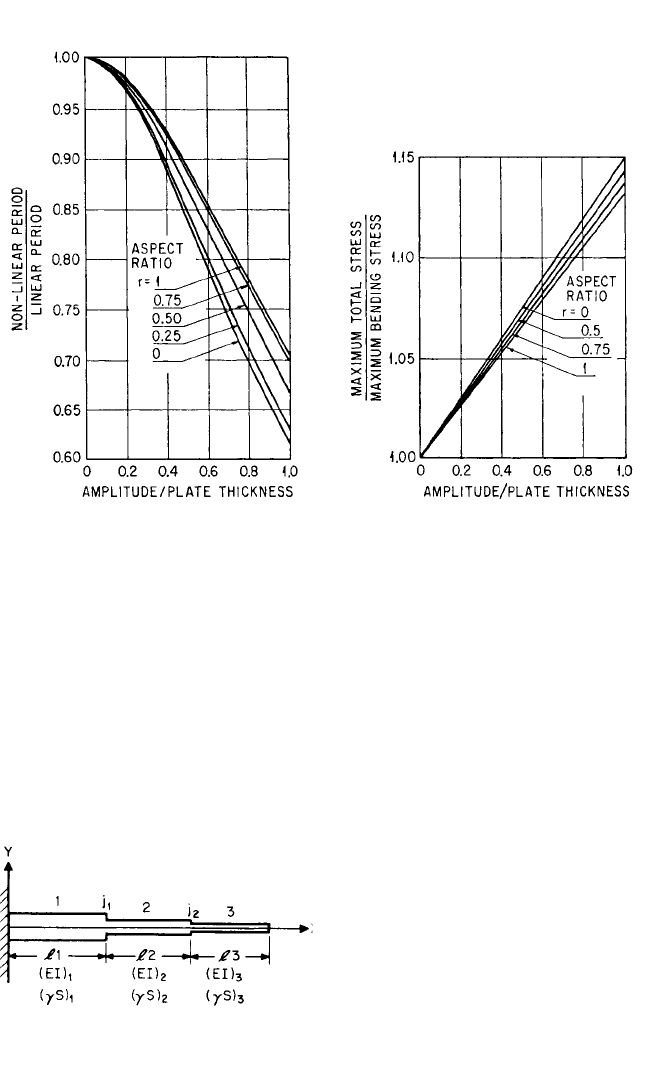
TRANSFER MATRIX METHOD
In some assemblies which consist of various types of elements, e.g., beam segments,
the solution for each element may be known. The transfer matrix method
44,45
is a
procedure by means of which the solution for such elements can be combined to
yield a frequency equation for the assembly. The associated mode shapes can then
be determined. The method is an extension to distributed systems of the Holzer
method, described in Chap. 38, in which torsional problems are solved by dividing
an assembly into lumped masses and
elastic elements, and of the Myklestad
method,
46
in which a similar procedure
is applied to beam problems. The
method has been used
47
to find the nat-
ural frequencies and mode shapes of
the internals of a nuclear reactor by
modeling the various elements of the
system as beam segments.
The method will be illustrated by set-
ting up the frequency equation for a can-
tilever beam, Fig. 7.13, composed of
three segments, each of which has uni-
7.40 CHAPTER SEVEN
FIGURE 7.11 Influence of amplitude on
period of vibration of uniform rectangular
plates with immovable hinged edges. The aspect
ratio r is the ratio of width to length of the plate.
(H. Chu and G. Herrmann.
39
)
FIGURE 7.12 Influence of amplitude on max-
imum total stress in rectangular plates with
immovable hinged edges. The aspect ratio r is
the ratio of width to length of the plate. (H. Chu
and G. Herrmann.
39
)
FIGURE 7.13 Cantilever beam made up of
three segments having different section proper-
ties.
8434_Harris_07_b.qxd 09/20/2001 11:24 AM Page 7.40
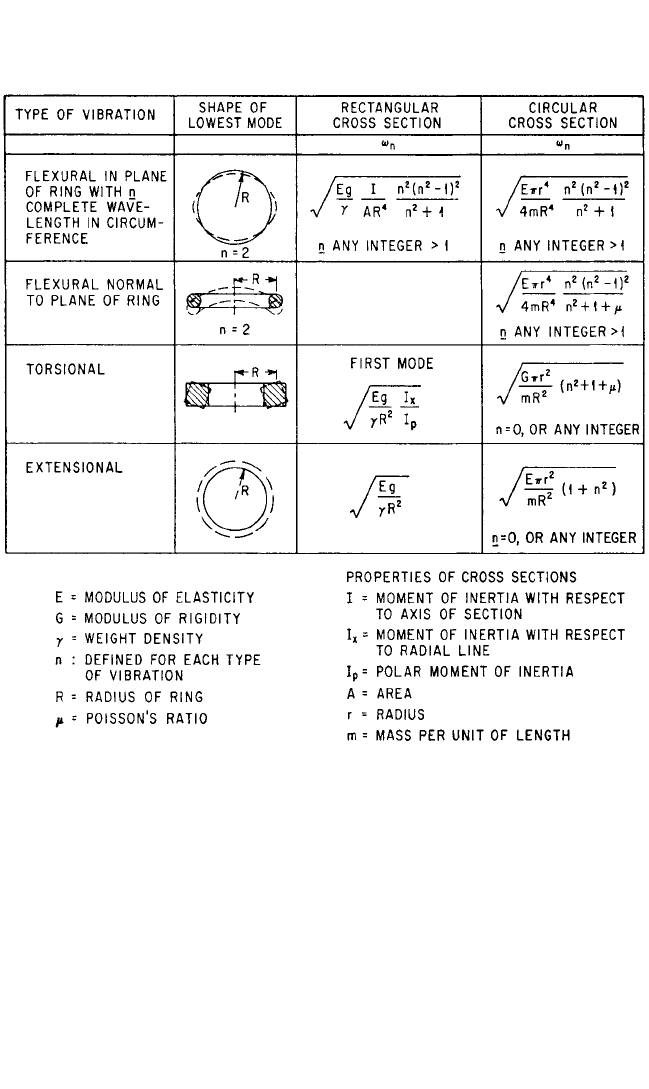
form section properties. Only the effects of bending will be considered, but the
method can be extended to include other effects, such as shear deformation and
rotary motion of the cross section.
45
Application to other geometries is described in
Ref. 45.
Depending on the type of element being considered, the values of appropriate
parameters must be expressed at certain sections of the piece in terms of their val-
ues at other sections. In the beam problem, the deflection and its first three deriva-
tives must be used.
Transfer Matrices. Two types of transfer matrix are used. One, which for the
beam problem is called the R matrix (after Lord Rayleigh
44
), yields the values of the
parameters at the right end of a uniform segment of the beam in terms of their val-
ues at the left end of the segment. The other type of transfer matrix is the point
matrix, which yields the values of the parameters just to the right of a joint between
segments in terms of their values just to the left of the joint.
VIBRATION OF SYSTEMS HAVING DISTRIBUTED MASS AND ELASTICITY 7.41
TABLE 7.11 Natural Frequencies of Complete Circular Rings Whose Thickness in Radial
Direction Is Small Compared to Radius
8434_Harris_07_b.qxd 09/20/2001 11:24 AM Page 7.41

As can be seen by looking at the successive derivatives, the coefficients in Eq.
(7.16) are equal to the following, where the subscript 0 indicates the value of the
indicated parameter at the left end of the beam:
A = C = B = D =
Using the following notation, X and its derivatives at the right end of a beam seg-
ment can be expressed, by the matrix equation, in terms of the values at the left end
of the segment. The subscript n refers to the number of the segment being consid-
ered, the subscript l to the left end of the segment and the subscript r to the right end.
C
0n
=
S
1n
=
C
2n
=
S
3n
=
where κ
n
takes the value shown in Eq. (7.14) with the appropriate values of the
parameters for the segment and l
n
is the length of the segment.
X
C
0n
S
1n
C
2n
S
3n
X
X′κ
n
4
S
3n
C
0n
S
1n
C
2n
X′
X″
=
κ
n
4
C
2n
κ
n
4
S
3n
C
0n
S
1n
X″
X″′
rn
κ
n
4
S
1n
κ
n
4
C
2n
κ
n
4
S
3n
C
0n
X″′
ln
or x
rn
= R
n
X
ln
, where the boldface capital letter denotes a square matrix and the
boldface lowercase letters denote column matrices. Matrix operations are discussed
in Chap. 28.
At a section where two segments of a beam are joined, the deflection, the slope, the
bending moment, and the shear must be the same on the two sides of the joint. Since
M = EI ⋅ X″ and V = EI ⋅ X″′, the point transfer matrix for such a joint is as follows,
where the subscript jn refers to the joint to the right of the nth segment of the beam:
X
10 0 0
X
X′ 01 0 0 X′
X″
=
00(EI)
l
/(EI)
r
0 X″
X″′
rjn
00 0 (EI)
l
/(EI)
r
X″′
ljn
or x
rjn
= J
n
x
ljn
.
The Frequency Equation. For the cantilever beam shown in Fig. 7.13, the coef-
ficients relating the values of X and its derivatives at the right end of the beam to
their values at the left end are found by successively multiplying the appropriate R
and J matrices, as follows:
x
r3
= R
3
J
2
R
2
J
1
R
1
x
l1
−(sin κ
n
l
n
− sinh κ
n
l
n
)
2κ
n
3
−(cos κ
n
l
n
− cosh κ
n
l
n
)
2κ
n
2
sin κ
n
l
n
+ sinh κ
n
l
n
2κ
n
cos κ
n
l
n
+ cosh κ
n
l
n
2
−X
0
″′
2κ
3
−X
0
″
2κ
2
X
0
′
2κ
X
0
2
7.42 CHAPTER SEVEN
8434_Harris_07_b.qxd 09/20/2001 11:24 AM Page 7.42
